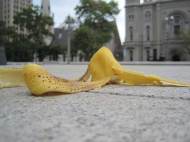Norway getting a plant that turns organic waste into biogas and biofertilizer
 Organic waste such as banana peel, coffee grounds and other food waste, will be processed in a new plant in Norway which transforms it into biogas that can be used to power Oslo’s city buses. The new plant designed to perform that task will be located north of Oslo and it should be in operation from next year, and it will also be used to produce nutrient-rich biofertilizer that is already sterilized and odor-free.
Organic waste such as banana peel, coffee grounds and other food waste, will be processed in a new plant in Norway which transforms it into biogas that can be used to power Oslo’s city buses. The new plant designed to perform that task will be located north of Oslo and it should be in operation from next year, and it will also be used to produce nutrient-rich biofertilizer that is already sterilized and odor-free.
The contract for plant construction is assigned to Norwegian company Cambi AS – a company that has been developing technology for converting biodegradable material into renewable energy for over 20 years. So far the company has designed and delivered 28 plants for converting biodegradable material into renewable energy.
The new plant will produce biogas using a method known as thermal hydrolysis, whereby raw materials such as waste or sewage sludge are boiled under both high temperatures and pressure. Cambi has worked out a hydrolysis process that yields substantially more biogas compared to conventional facilities.
The plant will be able to process 50,000 tons (100,000 pounds) of food waste per year, converting it to biogas fuel for 135 municipal buses as well as enough biofertilizer for roughly 100 medium-sized local farms. Combined with Oslo’s 65 biogas powered buses which are powered by biogas produced from sludge from the city’s sewage treatment plant, the local bus company will have enough biogas for at least 200 buses, or an energy equivalent of 4 million liters of diesel fuel per year.
“Running on biogas will reduce emissions from public transport, which means less airborne particulate matter and thus improved air quality in Oslo. What’s more, the biogas buses run quietly”, said acting plant manager Anna-Karin Eriksson of the Oslo Municipality Waste-to-Energy Agency (EGE).
The waste from the biogas production process could be used as liquid fertilizer with roughly the same nutrient content as compound fertilizer. The new plant will supply both liquid and solid biofertilizer in addition to a liquid concentrate.
“We’ve shown that biowaste has substantial value in itself and is well worth utilizing”, said Per Lillebø, chair of Cambi ASA. “The fertilizer produced is a vital part of the biological cycle.”
Cambi’s Research Council funding was provided under the Large-scale Research Programme on Clean Energy for the Future (RENERGI). The company is also an industry partner in the Bioenergy Innovation Centre (CenBio), one of Norway’s 11 Centres for Environment-friendly Energy Research.










We will arrange to take up the operation and will interact with the residents for source segregation and the segregated waste will be transferred to OWC room by the housekeeping staff.
Visit more: http://www.vennarorganic.com/news.html
I watched T. Boone Pickens talking about natural gas on TED 2012, and these plants would be a nice addition to the bridge to an oil-free future that produces useful biofertilizer as well.
Excellent. Such processes should be started in Developing countries.
Dr.A.Jagadeesh Nellore(AP),India
E-mail: anumakonda.jagadeesh@gmail.com